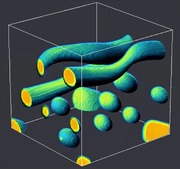Visualization of Fluid Flow in Porous Media
Summary:We are computing fluid flow through porous media using the Lattice Boltzmann method. In the Lattice Boltzmann method particles are allowed to move and collide on a lattice. The rules governing the collisions are designed such that the time-average motion of the particles is consistent with the Navier-Stokes equations. The Lattice Boltzman method has multiple advantages including:
Visualization helps develop a conceptual framework for understanding complex physical processes. In particular with fluid flow, visual comparisons with experiment are important to validate models. The visualizations were created using a variety of standard scientific visualization techniques and software. The two-dimensional images were created by taking a cross-section of of the three-dimensional model and mapping fluid density to color and intensity. In the three-dimensional images, fluids are depicted with isosurfaces and volume visualization techniques using color, intensity, and transparency to indicate fluid density. Fluid movement is expressed by assembling visualizations at a series of time steps into animations. The three-dimensional images also use isosurfaces to delineate the structure of the medium such as the sandstone, or the surface of the tube structure within which the fluid flow is being modeled. Staff:
Links:
Publications:
Return to Visualization |
Return to Visualization
Porous Media:
Two dimensional cross section of two-component fluid flow through a porous medium. This is a single frame from an animated sequence:
Measured and modeled permeabilities of Fontainebleau sandstone media. Click on image for larger version.
Two animations of the Taylor-Tomitaka instability. These two animations depict the same data from different vantage points.
Phase Separation of a Two Component Fluid This animation shows a lattice Boltzmann simulation of phase separation of a 15% - 85% relative composition fluid mixture (an off-critical mixture) under steady shear. The quench depth parameter is 0.287 and the reduced shear rate is 0.56.
This animation is available at two resolutions and in two formats: High Resolution:
Low Resolution:
|






